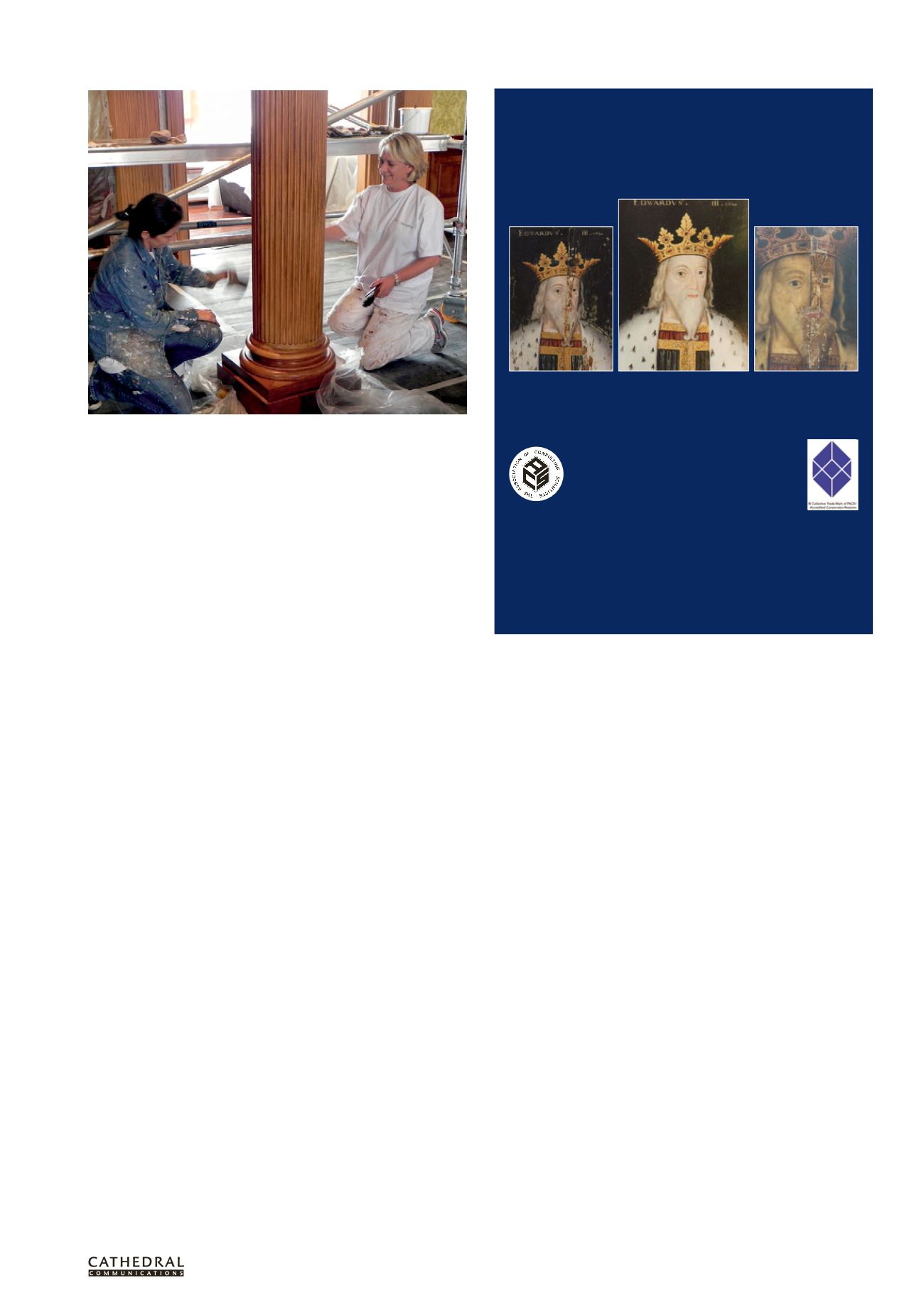
T W E N T Y F I R S T E D I T I O N
T H E B U I L D I N G C O N S E R VAT I O N D I R E C T O R Y 2 0 1 4
1 6 5
INTERIORS
5
FINE ART CONSERVATORS
◾
◾
FRANCIS W DOWNING ACR SPECIALIST
PAINTINGS CONSERVATOR AIFCA
203 Wetherby Road, Harrogate, North Yorkshire HG2 7AE
Tel 01423 886962
Email
RESTORATION AND CONSERVATION OF PAINTINGS
: Each painting is an
individual work requiring specialised care and consideration when
cleaning and conserving. The studio was established in 1976 to clean and
conserve paintings and paintwork in oil, tempera and acrylic, on canvas,
panel and wood structures to the highest standards of conservation for
private clients, historic houses, churches, museums and galleries. With
photographs and detailed reports prepared during the work, ensuring
that ethical guidelines are recorded at every stage. X-ray, infrared,
ultra-violet and chemical analyses are used to aid examination. However,
there is generally no charge for initial examinations or quotations. With
full professional indemnity insurance, the practice covers the UK and
Europe. Francis Downing also works as a forensic conservator and
investigator for police, auctioneers and insurance companies. Over
36 years experience of art conservation, research and recovery. See also:
display entry above.
◾
◾
HIRST CONSERVATION
Head office – Laughton, Sleaford, Lincolnshire NG34 0HE
Tel 01529 497517
▪
▪
London office – 75 Cowcross Street, London EC1M 6EL
Tel 0800 068 5418
Email
INTERNATIONAL CONSERVATORS OF FINE ART
: See also: display entry on the
inside front cover and profile entry in Mortars & Renders, page 146.
Francis W Downing
Restoration and Conservation
of Paintings
Francis W Downing ACR
203 Wetherby Road, Harrogate, North Yorkshire HG2 7AE
Tel: 01423 886962 Email:
The Studio was established in 1976 to clean and conserve
paintings on canvas, panel and fixed structures to the highest
standards of conservation for private clients, historic houses,
churches, museums and galleries.
• Full professional indemnity insurance
• Full UK and European coverage
• Francis Downing is an Accredited
Member of the Institute of Conservation
Over 36 years experience of art conservation, research and care
Softening the freshly grained surface of a column using badger haired brushes
(Photo: Hare & Humphreys)
medium gave less protection to its constituents than oil, the work was
almost always varnished.
THE PRESENT DAY
The use of graining waned after the first world war, not least because
the technique is so labour-intensive, and the rise of Modernism sealed
its fate. However, wherever thick layers of paint remain on historic
joinery, evidence for decorative wood graining schemes may well lurk
beneath. Clearly, this paintwork is a rich repository of information
which can reveal not only where and when graining schemes were
used, but also the types of wood that were being imitated.
Paint stripping prior to repainting will reveal the lines of the
original mouldings more clearly, but the secrets contained in that
layer of paint will also be lost forever. If paint analysis cannot be
carried out before it is stripped, careful thought should be given as to
whether it is really necessary to strip all the paintwork, or whether
there are areas that could be over-painted.
Recommended Reading
IC Bristow, Interior House-Painting Colours and Technology 1615–1840,
Yale University Press, London, 1996
EA Davidson, A Practical Manual of House Painting, Graining,
Marbling and Sign Writing, Lockwood & Co, London, 1875
J Fowler and J Cornforth, English Decoration in the Eighteenth Century,
Barrie & Jenkins, London, 1986
C Gere, Nineteenth-Century Decoration: The Art of the Interior,
Weidenfeld and Nicolson, London, 1989
AS Jennings, The Modern Painter and Decorator: A Practical Work
on House Painting and Decorating, Caxton Publishing Company,
London, c1947
P Nicholson, The Builder’s and Workman’s New Director,
A Fullarton and Co, London, 1854
J Pincot, Pincot’s Treatise on the Practical Part of Coach & House
Painting, London, 1811
PF Tingry, The Painter’s & Colourman’s Complete Guide,
Sherwood Gilbert and Piper, London, 1830
N Whittock, The Decorative Painter’s and Glazier’s Guide,
London, 1827.
MSc AA Dip(Cons) MA is an architectural
paint researcher working in private practice with over 25 years’
experience in building conservation
. Past research
projects include William Morris’s Red House, Walthamstow,
No 1 Royal Crescent, Bath and various galleries at the Victoria &
Albert Museum, London, as well as numerous other properties
in both private and public ownership. In addition to publishing
articles on the subject she has also participated in the television
programmes Restoration and The Manor Reborn.


